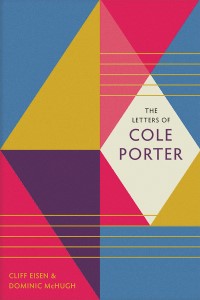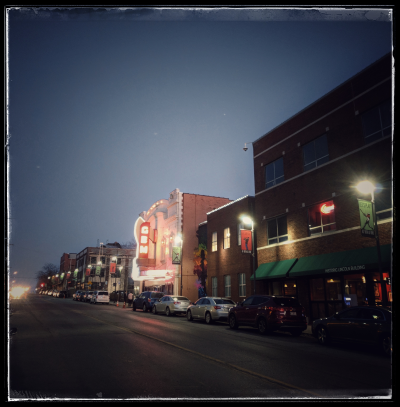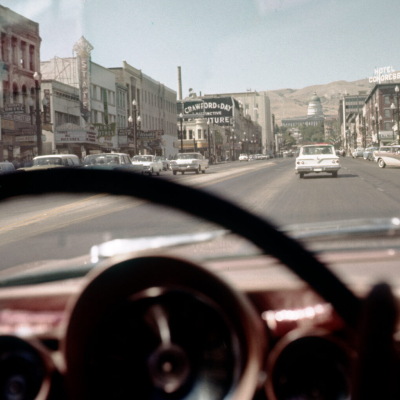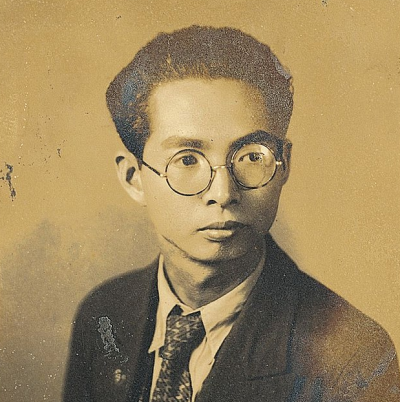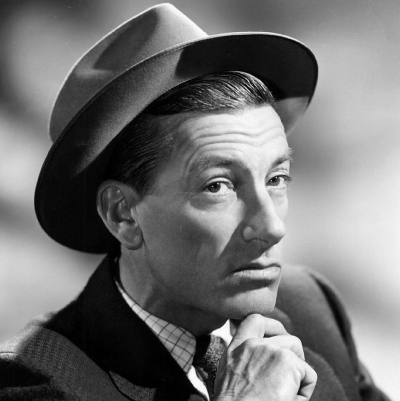.
.

Dominic McHugh, co-author (with Cliff Eisen) of The Letters of Cole Porter
.
___
.
…..Much is known about the life and genius of songwriter Cole Porter, whose music appears in many of Broadway’s most successful and beloved musicals, including Kiss Me Kate, .Can-Can. and .Silk. Stockings. His most popular tunes are found at the heart of the Great American Songbook, “Night and Day,” “I’ve Got You Under My Skin,” “In the Still of the Night” and “You’re the Top,” among them, and his work also touched Hollywood, in films like .Born to Dance, Rosalie, High Society, and. Les Girls.
…..Several Cole Porter biographies and biographical films have been written and produced, enough to acquaint us with a meaningful understanding of his life – of his wealth and luxurious lifestyle, his sexuality and marriage, and his tragic horse riding accident that caused lifelong pain and, eventually, a leg amputation.
…..In The Letters of Cole Porter, a comprehensive collection of surviving correspondence that has recently been published, much of what is known about Porter is discussed by Porter and his family, friends, and business associates. In our interview with Dominic McHugh, the book’s co-author (with Cliff Eisen), he explains that one of the results of the book is that “several of the big biographical tropes that we associate with Porter are either modified or contested by the letters,” and that “when you put together these letters, and add our quite extensive commentary between the letters, it creates a different picture of him. Our idea was to show what the archives say about Cole Porter in contrast to what people think about him.”
…..This book is revealing and, ultimately, wonderfully rewarding. It helps being a Porter fan, but it isn’t necessary because the correspondence is an often entertaining inside look at a complicated man – wealthy but frequently anxious about money; gay yet in love with his wife; devoted friend who embraces relationships and the challenge of his work with warmth and delight until health issues finally overcome his spirit.
…..Mr. McHugh discusses his book, and what the letters reveal about the life – in-and-out of music – of Cole Porter.
.
.
___
.
.
This interview took place on February 26, 2020, and was hosted and produced by Jerry Jazz Musician editor/publisher Joe Maita
.
.
photo unattributed/ Public domain
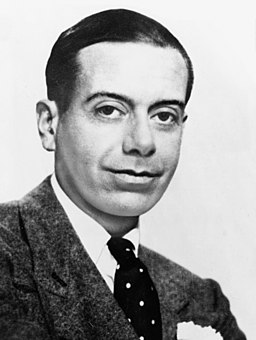
Cole Porter in the 1930s
.
“Even before considering the implications of the facts and details contained in the letters, [nuances within the letters] speak volumes about Porter’s character and offer both the scholar and the general reader new insights into an important historical figure who is at once familiar and yet curiously distant. Of course, the details are where the true surprises lie.”
-Cliff Eisen and Dominic McHugh, in the preface to The Letters of Cole Porter
.
.
Listen to Cole Porter play piano and sing “Anything Goes,” a song from his 1934 musical, Anything Goes
.
___
.
JJM .What is your background?
DM.I am a musicologist at the University of Sheffield, and my research is all about Broadway and Hollywood Musicals of the middle of the 20th Century. Prior to that I studied a range of music, and was especially passionate about nineteenth-century Italian opera. Just as I was choosing topics for my PhD I decided to do Lerner and Loewe’s My Fair Lady rather than Giuseppe Verdi, and to my surprise I have ended up staying with the American musical as a topic and have since published six books on musicals. The next one is on Meredith Willson’s The Music Man.
JJM . I understand you are currently working on a book around the letters of George Gershwin…
DM. Yes..Cliff Eisen, who co-authored The Letters of Cole Porter, was my PhD adviser many years ago, and we are doing a series of books on composer’s letters, including Gershwin, Frank Loesser, and possibly Irving Berlin. We are finding it very interesting to show how the surviving correspondence of these artists doesn’t necessarily uphold who we think they were, and from these letters we are getting a clearer picture of what their world was like.
JJM. Adam Gopnik in a.New Yorker.review of your book said that “Certainly, Porter’s ghost could not ask for better care than he has been given in The Letters of Cole Porter,” and The Washington Post calls your book “an intimidating marvel of scholarship.” What inspired you to put this impressive project together?
DM. Cliff is one of the great Mozart experts, and he is currently working on the letters of Mozart, which is a multi-volume project that he has been working on most of his life. So we both have a passion in our research for looking at everything. The way people think of the kind of figures we are looking at – including Porter and Gershwin and Mozart – is very heavily influenced by myth, and when we look at all these sources for these figures, we came to realize that there is a story to be told through their letters.
In the case of Porter, several of the big biographical tropes that we associate with Porter are either modified or contested by the letters, and some of the other tropes are completely missing in the letters. We understand that probably 98 percent of the correspondence is missing or has been destroyed because people don’t tend to keep letters, so we only have the portion of letters that survived. Nevertheless, there is something striking about looking at Porter’s life in his own words. Sometimes letters were written to a close friend, and other times they were to his mother, wife or business associate, and he is thinking about that particular audience every time he writes. Regardless of who he is writing to, when you put together these letters along with an extensive commentary between them, it paints a different picture of him. So our idea was to show what the archives say about Cole Porter in contrast to what people think about him.
JJM .In the book’s preface you say that Porter’s life remains “comparatively unexamined.” What do these letters tell us about Porter that wasn’t previously known?
DM.One example comes very early in the book, in a group of letters from Porter’s school headmaster to Porter’s mother. The headmaster gives her an account of what Porter was like as a child at school, and writes that all Cole wanted to do was practice piano; he didn’t want to do any work. Correspondence like that indicates that from childhood, music meant a great deal to him. Other letters report of his misbehavior, or that he is not feeling well, and when you read them you can’t help but wonder if this is the true Cole Porter since the headmaster is writing Porter’s mother as the person caring for her son, which is essentially a business relationship. This is just a good example of how it is not always clear about what the letters actually tell us. It is up to us and the reader to make our own interpretation, surmising that they show certain early personality traits – that he liked to have fun, but he also had a passion for music. We didn’t really know that before we read these letters.
Unknown photographer / Public domain
Portrait of Cole Porter, Yale College B.A. 1913
Another striking example of what we learned about Porter from these letters is that while everyone has assumed he inherited lots of money, and therefore life was easy and he didn’t really even need to write his musicals or songs, the letters show the opposite – that he was constantly in debt, constantly borrowing money from his mother, and constantly worried about how to pay his tax bill. Another thing that is related to that is that the letters, specifically those about the musicals Can-Can and Aladdin, often describe his creative process. Discussion with script writers of those musicals tells us something new about Porter, who we assumed that because he was rich he was just doing this for fun, or that it came easy to him. Instead, we are seeing his craftsmanship in these letters – they reveal that he thought about songwriting in a great deal of detail and that it is highly constructed. So his songs aren’t something that just happened because he was rich and he went to a party or that he was inherently witty – they were entirely created from the ground up. This re-frames Cole Porter for us.
A driving general theme of the letters is Porter’s sexuality. Everyone knows that Porter had a lot of casual relationships with men, but one of the themes of the book is how much he cares for his wife Linda, and it first shows up in a 1918 in a letter to Monty Woolley – his best friend at that time – where he describes falling in love with her. That was quite unexpected to me because he actually even referred to it as the “real thing.” So, even though there are then numerous love letters and flirtatious letters to men throughout the rest of his life, one of the most sincere things in the book are the letters showing his concern for the health of his wife, who was frequently very ill from emphysema..She was his greatest priority and he went to great lengths to try to make her comfortable and to get her the best medical care available and to sort things out for her. So, there are specific things, but there are also these general things where the letters actually paint, potentially, a different picture of Porter than the one we know.
JJM. Were these letters utilized by his biographers?
DM .Some of them were, but others are newly available. The important point is that even biographers who had access to some of them were mediating between the letters and the reader. Since the biographers didn’t reproduce the letters in full, while they may refer to the letters they characterize them in a way that is a personal interpretation, and not necessarily what other people may get out of them. For example, William McBrien’s 1998 book – the standard biography of Porter, which is very detailed and very good – does tend to dramatize his life and his motivations in an exaggerated way, and when you read the letters that these assertions are based on, it is hard not to disagree. In the context of all his correspondence, some of his attitudes aren’t as impassioned or angry as McBrien would suggest, and that’s typical of all the Porter literature. So, having access to these letters allows people to paint their own picture of Porter.
JJM .His marriage to Linda may be interpreted as one of “convenience,” but their deep love for one another shows up in various ways in the letters. She seemed understanding about his sexuality, but there is also evidence in the letters that this didn’t always sit well with her – at one point she even moved to Paris prior to World War II to get away from him…
DM .Yes, people tend to make a lot of assumptions about their marriage. You often read comparisons between Cole Porter and Noel Coward, for example – both of whom we are told are gay men, which assumes they were sort of in the same situation. They were around at the same time, navigating the same “problem” in society concerning their sexuality, but they are quite different because Porter made the decision to marry a woman. So if we look at that 1918 letter to Monty Woolley about Linda, it is striking that he is not saying to him: “Well, I have found someone I am going to marry out of ‘convenience,’ and she’ll do.” Instead, he describes falling in love and felt it was the “real thing.” Therefore, who knows how he felt about his sexuality or what he meant by it? And who knows what the arrangement between them was? There are various letters that indicated she would go traveling with Porter and his lovers, including at times traveling with the lovers but without Porter himself. The situation was entirely out in the open.
Linda Lee Thomas (Mrs. Cole Porter)
1919 passport photo
There is an indication, as you said, that there was a point in the 1930s where Linda became exasperated, but we don’t really know what that was about because other than there being a sense of tension between them, the letters don’t particularly touch on it very much. Porter had a serious horse riding accident in 1937, and Linda came back to look after him, and they were very close for pretty much the rest of her life – she died in the early 1950s. So it seems from that point on they were very close.
In the 1940s they would spend weekends in their house in Massachusetts, and Linda would stay in the main house while Cole stayed with whichever male lover he had at the time in the small cottage he built on the property. They would all have dinner in the main house together, so Linda very much knew what was going on. But the relationship between them is so very tender, and she is fiercely defensive about his talent. For example, Rodgers and Hammerstein were not great friends with Cole Porter – there was some kind of tension between them – and when Linda heard some songs from South Pacific on the radio, she wrote a letter to Cole, and said, “How could their music compare to yours?” There is a real sense of how she thought he was a genius and supported him, and in turn, he brought in the best doctors in an attempt to solve her health problems that were generally a source of constant concern for him. It was a very interesting marriage, and to call it a “marriage of convenience” when there is that much care and tenderness going on seems to really misrepresent it.
JJM.There is no doubt readers will come away feeling as if there was an authentic tenderness between them, and he expressed that in virtually every sentence he wrote about her.
DM .Yes, that’s right.
JJM.There are not many surviving letters to his male lovers, but the ones that do exist are to the Russian ballet dancer Boris Kochno, and to the dancer and choreographer Nelson Barclift. Those to Kochno are most revealing…
DM . Yes, this is fascinating because Kochno was the Russian ballet impresario Serge Diaghilev’s lover, and he was very much a flirtatious figure in the ballet world in the 1920s. The series of letters you are referring to were written in French by Porter, which is perhaps unexpected. Porter seems to have been absolutely smitten with Kochno, almost to the point of being obsessed by him. The odd thing about the letters is that although quite specific reference is made to them having slept together – with Porter writing about how much he misses Kochno’s kisses – most of the letters are about Kochno not being in the same place with Porter, and about Kochno not writing back to Porter, who is desperate to hear from him and to see him. However, since we discovered that Kochno was also in a relationship with someone else at the time, Kochno probably didn’t care. We don’t know if Porter knew about that or even whether it would matter to him, but there is something very striking about this. It does feel like a very deep and intense relationship on Porter’s part, although part of me also feels that he spends a lot of time whining at and about Kochno. They don’t seem to spend a great deal of time together, although he evidently likes the time they do spend together.
In terms of Barclift, who was an actor in the 1940s, there is quite a different tone here. These letters were written almost twenty years later, and he was quite a bit older than Barclift, and he was quite paternalistic. It is clear that they are having sex but Porter is also giving a bit of life advice and career advice, and there is a slight sense of Porter talking down to Barclift, whereas he is begging Kochno to get back to him. So it is interesting how different those relationships are, and it is hard to know whether it is just because it is two different people and he felt different about them, or is it just because Porter is now twenty years older and has since become a big star and celebrity, and much wealthier. Again, this is the nature of this kind of research – we draw our own conclusions about these sorts of things, but it is very thought provoking concerning what it might mean about Porter. I certainly think that letters he wrote to Kochno are the kinds of letters people expect from Cole Porter.
.
A musical interlude…A 1932 recording of Fred Astaire singing Cole Porter’s “Night and Day,” which was written in 1932 for the Broadway musical The Gay Divorcee
.
JJM .In a September 16, 1925 letter to Kochno, Porter writes “Fortunately I’ve arranged to be in Florence on the 20th and 21st – perhaps the 22nd. I’m sure it will be very difficult to meet but in any case I will have the great luxury to look at those beautiful eyes of which I dream, night and day, my Boris.” This was seven years before “Night and Day” was written for the “Gay Divorcee” Was this a phrase that showed up in other letters, or did any letters ever reveal potential song lyrics?
DM .I think that is entirely fanciful, and this is another example of exactly what I mean about how people interpret the letters. I’m not saying that Porter never had any inspiration, but I think he was writing songs for specific moments in musicals and he was writing them on demand, and it is certainly too much to suggest that “Night and Day” is about Kochno without having some more serious confirmation about that.
What is problematic about Porter is that, like a lot of these sorts of writers, he would give interviews with the press and invent the inspiration for songs because it’s a good story and it sells well and the public likes it, but the letters do reveal that when he is in creative mode, it is almost like an intellectual puzzle for him. He thinks about how to construct the song, he thinks about phrases, he thinks about the words. In the 1950s he starts talking about trying to create simpler lyrics. He admires Irving Berlin because he thinks that Berlin has the art of simplicity and he, Porter, struggles with that – he tries to avoid being too wordy, which is very interesting.
So, it is possible that he liked saying “night and day,” but I don’t recall it being in any other letters. When you are writing for characters in musicals, if you are writing a song lyric that is about Boris Kochno, sung by Reno Sweeney, or by a character played by Fred Astaire, then you have done a really bad job because they don’t automatically transfer from one to the other, and if they do transfer it is because they are so general and generic that it can’t be a very good song.
JJM .He was frivolous with money he received from his mother Kate, and was generally anxious about money until his mother’s death, when he inherited half-a-million dollars. In August of 1951 he wrote to his lawyer Ben Schankman concerning his “constant dread” about his finances, and his wife Linda wrote to his friend Sam Stark that Cole “worries about everything.” Did any of these letters help understand what was at the heart of his financial anxiety?
Unknown photographer / Public domain
Cole Porter, Linda Lee Thomas, Bernard Berenson, and Howard Sturges in gondola, Venice, 1923
DM .Well, he had a problem. He had quite a lot of money, but he spent it. He enjoyed a lavish lifestyle – he was brought up on it, and then his lifestyle became even more lavish as the years went on. He also had a problem because when musicals of his were successful his income suddenly rose very dramatically, very quickly, resulting in him suddenly owing a lot of taxes. And, in a year when he didn’t have a musical, or if a musical flopped, then everything would fall again, so his income would drop and the taxes he owed would drop. So, very often he would suddenly have a massive tax bill in a year following a successful show, but he may no longer have the income to pay it because he may not have followed it up with another hit show. Consequently, there is precariousness to his finances. He didn’t go out of his mind, but he drove himself to great stress in the early 1950s about whether he was going to be able to continue to churn out hit after hit.
Kiss Me, Kate in 1948 was such a success – it sort of confirmed him as the king of Broadway – but then his next show, Out of This World, was very disappointing. There were big problems with the book and they tried to sack the book writer, and then they brought him back, and then other people (Comden and Green) came to work on it briefly, but it was not a financial success. Porter was really depressed about that. His valet took him to Europe to recuperate but had a nervous breakdown, basically, so they secretly flew him back into the country and put him in the hospital, where they gave him electro-shock treatments, which was quite common in those days. Then he wrote Can-Can, Silk Stockings, and High Society, which brought things back around for him, but that breakdown was related to financial burden and anxiety about whether his creativity was going to be there to provide the lifestyle he wanted.
Used by permission of the author
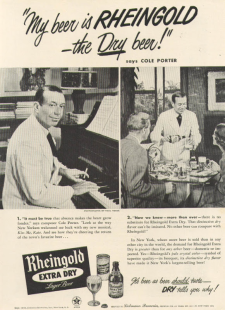
Porter in a 1953 advertisement for Rheingold Beer
JJM .Porter seemed to have a lack of business acumen, and Irving Berlin became not only an inspiration and friend, but a business model as well. At one point he talked about following Berlin’s path regarding ownership of his songs, and joined ASCAP in the 1950s. So he made attempts to get more informed and smarter about his finances…
DM .Yes. What happened is that he got a new lawyer and a new agent in 1948, John Wharton, who basically took over his business and began advising him about what to do and how to exploit his name. For example, they devised ways for Porter to put his name to products like dog food, or cigars, or cocktail napkins, and he started making money from these endorsements.
The nature of the book is interesting because the heart of the letters are from the last 16 years of his life, and because his law firm held on to all of their correspondence with him and of firms they negotiated with about Porter, after his death they became part of the Cole Porter Trust. So that part of his life is the best covered and best represented by the letters, and it also coincides with this shift in his life and career when he was getting different and better advice. In the end, the firm basically told him that he doesn’t have any financial worries anymore.
JJM .Another well known part of his biography, of course, is the 1937 horse riding accident that crushed his legs. How did he correspond with his friends about this accident over the years?
DM . That’s hard, because the accident was very bad. The horse trampled on both of his legs and in the end he had to have one of them amputated, but that was more than twenty years after the accident, so he lived with pain for more than two decades. The way in which he describes what was wrong with him is hardly matter-of-fact. Following the accident, when he was in the hospital and sort of just coming around, he writes to one of his friends, describing all of the things that are wrong with the bones – like how the bone is sticking through the skin and how the skin is infected. There is nothing dramatic about it, it is almost like he is enjoying being very dry about it, but there is no doubt that it affected him profoundly, because he would never walk well again. He would go on holiday and have to be carried places, and in the end he died in seclusion because, as far as we can tell, he was ashamed about having had a leg amputated. That was the end of his creativity – he didn’t write any more songs after the amputation – and there is a shift in his social habits too. When the film Can-Can came out in 1960 he didn’t even see it because he didn’t want to be seen in public, he sent his servants and friends to see it. So, the accident didn’t have that profound effect initially.
JJM . I didn’t pick up a lot of self-pity in his letters. There was certainly some appropriate complaints – after all, anyone who has that kind of life changing accident is to be forgiven for feeling lousy about it – but it isn’t as if that was all he wrote about. He wasn’t consumed by it, and even seemed courageous about his circumstances.
DM .Yes, he was dignified, wasn’t he? On some levels he was very accepting of the accident, which is a little hard to figure out since it was so awful, but then we must also remember that other people report in their letters that he was depressive. So, even to friends that knew he was depressed, he would pretend not to be depressed, but they would know, and we see that in one or two secret letters later on from Sam Stark, who was one of his closest friends,to Porter’s secretary Madeline P. Smith, talking about how worried he is about Cole because he didn’t seem to be himself. And that’s where understanding the letters in context is useful, because if we just take Porter’s letters at face value, then yes he just accepted his situation, but if you look at what other people report, then we actually see that the picture is more complex.
.
A musical interlude…Ethel Merman sings “I Get a Kick Out of You,” a song written for the 1934 musical Anything Goes. This version is from the 1936 film of the same name. (Notice the alternate lyrics, replacing the famous original line “Some get a kick from cocaine” with “Some like the perfume in Spain”).
.
.
JJM . In an April, 1953 letter to Saul Chaplin, the musical director of the film Kiss Me Kate, Porter wrote; “One day I want to give a big party and invite nothing but Censors, to find out how their minds work.” This subject of lyric censoring occasionally came up in his letters. In one entertaining letter he was informed that the censors required him to remove the line “Some get a kick from cocaine” from his song “I Get a Kick Out of You,” for the 1945 film, Night and Day which he promptly replaced with “Some like the perfume in Spain” (which he had done years before). What do these letters reveal about his challenges confronting censorship?
DM . It is kind of interesting, isn’t it? I get the impression that despite that very amusing letter to Saul Chaplin, Porter accepted that censorship was in place. From the 1930s to the 1950s, filmmakers were governed by The Hays Code, and before they could be distributed nationally, all films had to be certified by it. In the process, various suggestive things would be censored. It is likely that Porter thought it was silly, but he accepted it. It is interesting that in the MGM films, quite a lot of the time it seems that the studio suggested what the replacement lyrics should be. Porter may make a comment or suggest a different word, but he basically accepted the changes and didn’t really bother fighting them or coming up with his own replacements. That is likely because most of his songs were written for Broadway or record albums, and on Broadway there wasn’t that problem with censorship, therefore he felt he had already done his job on the original song, and if some silly studio was going to censor it, then his attitude was sort of: “Oh well.” So it was an interesting situation. There were places that had local censorship, for example when Out of This World was previewing in Boston in 1950, changes had to be made there because of certain suggestive lyrics. This kind of thing certainly dogged him a lot, because he liked to write these witty, slightly naughty innuendo ridden lyrics, but as long as he thought he was happy with what he had written originally, he just accepted the situation.
JJM .He wrote a little in his letters about the differences between writing for stage and film…
DM . Well, they were quite different. There was a big cultural difference between Hollywood and Broadway, especially in those days, and we know this from the career of Harry Warren, who wrote dozens and dozens of hit songs but no one knew who he was because in Hollywood it wasn’t about the songwriters, it was about the stars, studios, producers and directors. In New York, the writers were the stars, in a way, so songwriters like Cole Porter, Jerome Kern, and Rodgers and Hart all preferred writing Broadway shows because they knew that their work would be respected and that they would have a voice. Most of these writers encountered having their work written or messed around with by Hollywood because Hollywood owned that movie work and it could just be changed without permission.
The other difference is that most Hollywood films of that period may have between four and seven songs, maximum, whereas Broadway shows could have twelve, fifteen or even twenty songs if you include the reprises, overtures, etc. So writing a Broadway show is much more like writing a score, whereas Hollywood would want him to write five hit songs that they could publish and have covered by all the popular singers of the day. They would make lots of money from these songs. It is quite a different focus, which is why most of these big songwriters were not keen to write for Hollywood. Irving Berlin was unusual because, for example, he was paid $75,000 to write the songs for Top Hat while retaining publication rights to them. That was a very unusual deal in Hollywood in the 1930s. It was a tough atmosphere for a writer and an artist.
JJM .One of the things that surprised me was that there was ample correspondence in the letters about Broadway and Hollywood, but none about the business of record album recordings. So many great artists – Sinatra, Ella, and Armstrong among them – recorded his songs, but not even a comment about them…
DM..He does make a very derogatory reference to some kind of pop album that included songs from .Can-Can, and he was very much aware of recordings of his songs, at one time demanding that MGM send him the pre-recordings for the .High Society songs before they had been filmed. In another letter he mentioned the soundtrack of .The Band Wagon, .which is not a Cole Porter score but it does show that he was very keen on his phonograph player..He must have been aware of Sinatra and Fitzgerald doing recordings of his songs but my guess is that those letters haven’t survived. But there is no record of him being delighted with them…
JJM .Or even being involved in a project…
DM . That wouldn’t have been his normal attitude. It is not what he did. He would attend rehearsals for Broadway shows, and performers would comment on how he had an impact on them, but he would not normally get involved with his music once it had been heard. It was out in the open, and his attitude was that as long as people left the tune alone, he was happy.
JJM . Yes, he wrote; “During the months of preparation the piece itself becomes something of a person to me – not always a nice person, perhaps, but at least some one that I’ve grown fond of. The minute it is exposed to its premiere audience, however, I feel that it’s no longer mine.”
DM . Yes, that is exactly the point.
JJM .He and Irving Berlin were among the only songwriters who wrote their own music and lyrics at the time, but there are a couple instances in his letters where he seems to be inviting collaboration, one with the Can-Can book writer Abe Burrows, and another time with Bella Spewack, the book writer of Kiss Me, Kate…
DM .People tend to think that Cole Porter didn’t care about the books of his shows – which is about how the songs fit in with the scripts – but these sets of correspondence actually reveal that he loved getting ideas from other people and accepted any challenges that they gave him. One common story about him is that he would play a new song for them, and if they didn’t love it he would destroy it. You do get a sense from these letters that if the book writers expressed any dissatisfaction, he would go back and try to improve the song, or to start again and come up with a better song.
The song from Kiss Me, Kate he wrote to Spewack about was “Brush up Your Shakespeare,” and it did not really concern collaboration. He basically tells her that he always had a low comedy number near the end of his shows and that he wrote this piece for the gangsters that she will need to accommodate. The song “I Love Paris” from Can-Can had a similar story where, to Burrows’ dismay, Porter just tells him that he was written this song and he will need to find a place for it.
On the whole, Porter is quite collaborative and hungry for that input. It’s hard to know whether that was always the case because we don’t have the correspondence from all the shows from the 1930s, and we don’t know whether he had a practice of asking for feedback throughout his entire career. Kiss Me, Kate strikes me as a very specific type of musical because you’ve got the sort of “Taming of the Shrew” songs and the backstage songs, so having input from Spewack on which bits of Shakespeare he had to focus on seems to be a very logical thing for a songwriter to ask.
.
A musical interlude…Listen to Virginia Bruce sing Cole Porter’s 1936 song “I’ve Got You Under My Skin,” from the 1936 film Born to Dance
.
.
JJM.A highlight of the book is the journal he kept while writing for the film Born to Dance that documented his meetings with MGM executives. There are several entertaining anecdotes, including how he performed songs for the executives, how the picture was cast, and how his song “I’ve Got You Under My Skin” was removed from the script for being inappropriate to the story, then replaced because the MGM executives wanted it back. Porter “knew it was wrong, and much too romantic a number for this character to sing.” There was also a great story in the diaries about Eleanor Powell dancing the song finale in front of the executives. This was a classic story of early Hollywood that he let us in on…
DM . Yes, these are the Born to Dance diaries from 1936. He kept a day-by-day diary of these crazy meetings where he would turn up with a song, and it would be a great song, and the executives would say they loved it, and then the next day they would say they hated it, and the day after they would love it again. It sounds like a completely crazy world. At the same time, I do wonder why he kept those diaries. It wasn’t his practice, really, to keep diaries. He did keep a short diary from the 1950s about his cruises around the Greek Islands and around Europe.
This Born to Dance diary includes entertaining information about writing songs for this film, and it seems entirely plausible that it is true because it is full of detail and quite indiscreet. He is being so rude writing about how stupid these various major figures were, and I am inclined to believe him. I would agree that this journal is a highlight of the book because there is an insight into his intelligence and humor, and it is an observation on Hollywood life and society. He comes across as being an observer in these meetings, soaking up the mad, crazy atmosphere of Hollywood at a time when Hollywood was only nine or ten years into the sound era.
JJM .You talked earlier about his depression, and toward the end of his life as major events cascaded—the passing of his wife and the amputation of his leg being most prominent examples – his letters took on a different tone. How did facing his own mortality show up in the letters to his friends?
DM.Well, it is very sad, isn’t it? Some people have asked me why I reproduced all those letters, because what you are referring to is quite a lot of pages in the final chapter where he is writing very short notes to friends and rejecting or ignoring invitations for visits, or to do things together. He is pushing people away, and I find that very moving. There are all these very short letters, and we didn’t include them just out of a concern for completeness, and I don’t think they are boring. I do think he is actually very sad, because you can see someone who was thriving throughout life, and suddenly it is as if life disappeared from him.
There are also letters among his friends from around that time where you can see them rallying around Porter as they sense his sadness. His secretary started being indiscreet to his friends, and the friends start being indiscreet to her as well. At one point he is stuck in hospitals, and the letters reveal that he can’t motivate himself to do anything anymore, and then in the end, before he died, it feels like he had given up on life. There is a difference in tone and something very authentic about these letters, and I don’t think there is an issue about possibly missing longer letters from that period, he was just genuinely down to the level of simply writing very short notes. It is an incredible trajectory and I think very moving.
JJM . What do you hope people will take in about Porter after reading your book?
DM .I hope that people will see him in a much more rounded way. The thing that matters to me most is that although he was so popular, and remains popular, people take for granted his brilliance, and I really wanted the book to show how much craftsmanship he had and how hard he worked, and how intelligent he was. I don’t think those qualities have really been appreciated before. The biographical nuances about his marriage and his wealth play into that, because once we see that life wasn’t necessarily so easy or comfortable for him, or that he had a lot of anxieties that played into what we understood about him as a songwriter – which is ultimately what really matters.
.
___
.
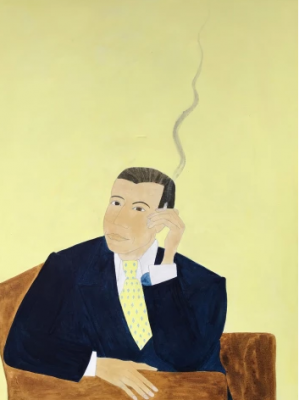
Painting of Cole Porter by. Kate Boxer
.
.
A brief excerpt from The Letters of Cole Porter (the authors introduce the letter)
.
…..In July, Noël Coward wrote to Porter to ask for permission to perform his own lyrics for ‘Let’s Do It’ during his cabaret residency in Las Vegas. In his response Porter mentions Linda’s health, which had only recently recovered from problems over the winter:
.
14 July 1953: Cole Porter to Noël Coward
.
Dear Noley:
…..Thanks a lot for your letter of June 11th, explaining the lyrics of LET’S DO IT.
…..I hear nothing but great reports about your different efforts.
…..We are having a heat wave here and I am in a constant rage. The reason I always come to this place for the summer is to avoid the horror of our east coast.
…..Linda is at our house in the Berkshires and having a ball. After being seriously ill most of the winter she is entirely well again and it makes me so happy every time we talk on the telephone. Her guests now are Mainbocher and his friend, Pollard. They stay through July and then Natascha [Wilson] and Nickie come up, so she is well taken care of while I gad about with the Goetzes.
…..Love,
…..[signed:] Cole
.
Click here to read a ten page excerpt from The Letters of Cole Porter
.
.
___
.
.
.
The Letters of Cole Porter
by
Cliff Eisen and Dominic McHugh
.
.
.

Dominic McHugh is Professor in Musicology at the University of Sheffield, U.K. He has published six books on American musicals, including .Loverly: The Life and Times of My Fair Lady (Oxford University Press) and .The Complete Lyrics of Alan Jay Lerner(Oxford University Press).
.
___
.
This interview took place on February 26, 2020, and was hosted and produced by Jerry Jazz Musician editor/publisher Joe Maita
.
.
Click here to read our interview with Richard Crawford, author of. Summertime: George Gershwin’s Life in Music, and click here to read our interview with James Kaplan, author of. Irving Berlin: New York Genius
.
.
.







